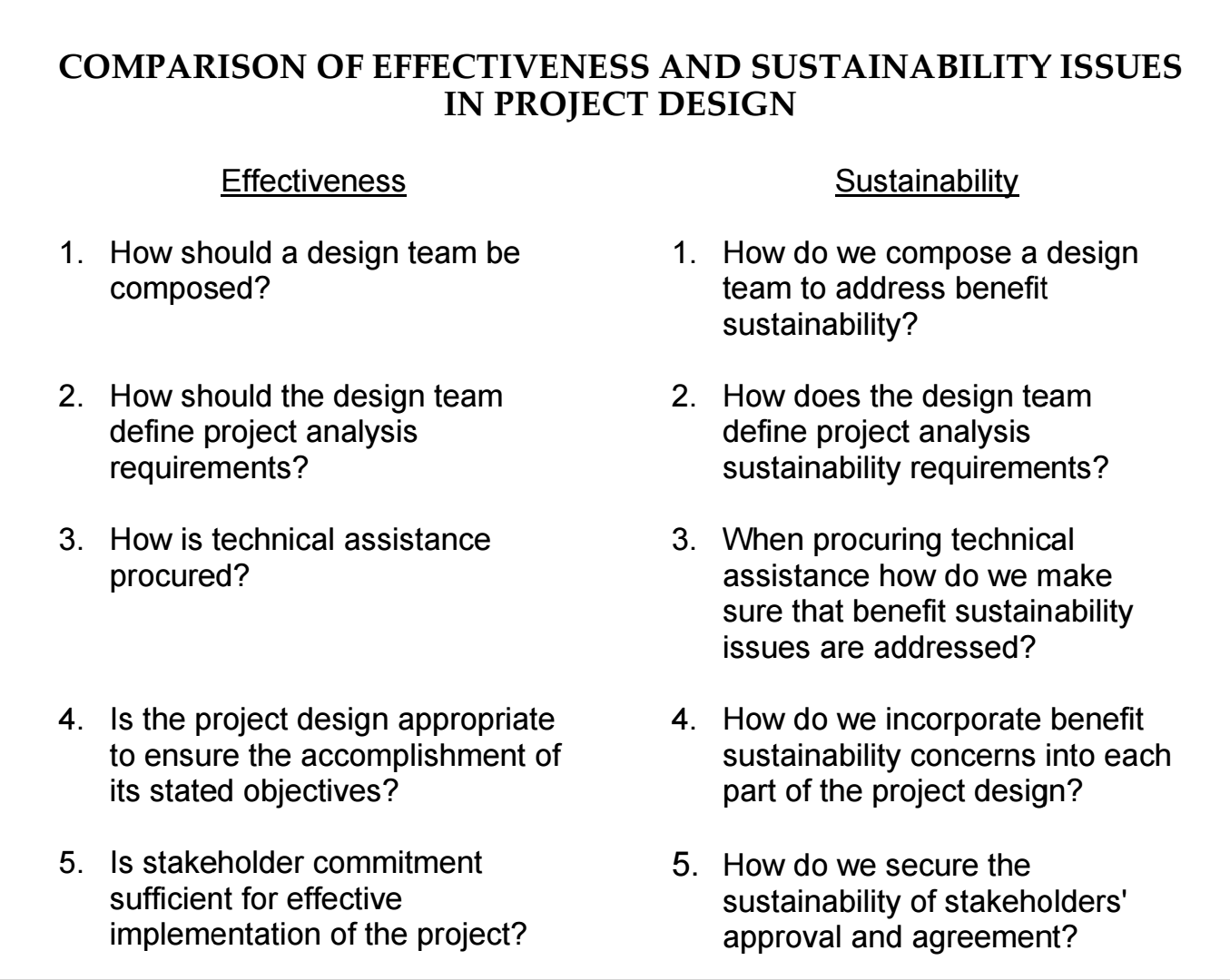SUSTAINABILITY IN PROJECT DESIGN
The project design or development phase presents a critical opportunity to ensure that crucial decisions reflect a concern for the sustainability of benefits beyond the investment period. During this phase of the project cycle, the design team determines what benefits the project will produce, by whom, and through what means. If these critical design decisions do not develop a project that fosters sustainable benefits, the scope for achieving sustainability by project termination will be severely limited.
The broad theme for the project design phase is cultivating conditions conducive to benefit sustainability. All facets of a project—including project objectives, goods and services provided, beneficiaries, means of distribution, and implementing organizations—affect whether benefits should and can be continued once donor funding ends.
While project design has traditionally focused on choosing project elements that produce the intended outputs, project design for sustainability needs a longer-term, strategic perspective that selects project elements that lead to desired outcomes. Beneficiary results over an extended time frame. Design decisions should support the critical factors for benefit sustainability.
BENEFIT SUSTAINABILITY MODEL
Sustainability in projects could be an added value and profitable if we implemented it correctly.
For most projects, the following factors determine whether or not benefits will continue to be realized after the termination of donor funding.
Client-responsive services
To develop an enduring constituency for benefit continuation, the specific project benefits must address a recognized need of the target population. Therefore, deciding on which benefits to deliver is predicated upon identifying the target audience and asking them what benefits they want from that audience. Needs are active, however. Therefore, gifts should be designed with sufficient flexibility to respond and adapt to changes in demand.
Strategic management capacity
Implementing organizations and the people who staff them are crucial influences on whether or not benefits continue. Individuals, supported by the organizational culture and standard operating procedures, must recognize and work toward long-term objectives, acknowledge and account for opportunities and threats in the external environment, and adapt the organization and its products to meet evolving needs continually.
Supportive institutional environment
Although many external factors are beyond the direct control of project managers, they greatly influence whether benefits will be sustained. Such factors include the policy and legal framework, bureaucratic culture and procedures, social norms, and economic and political conditions. Project managers can sometimes influence their environment to make it more hospitable. In instances where the climate is less amenable to change, project design should acknowledge and accommodate potential constraints.
Adequate resources
Benefits will not be produced without adequate resources—Financial, human, natural, and technical—to sustain them. Since development projects typically provide financial and often human and technical resources, benefits cannot continue post-project unless resources have been transferred to or can be acquired by the appropriate host-country organizations. Natural resources are finite and must be used responsibly to ensure their continued availability for the development of future generations.
Assuring these factors are in place implies different priorities and concerns for project design that transcend the critical issues for mere effectiveness. This additive consideration is illustrated by juxtaposing the effectiveness and sustainability questions below.

The benefit sustainability questions encompass the more conventional effectiveness issues while adding a longer-term perspective of benefit continuation. This perspective invites other, less traditional considerations for project design.
INCORPORATE SUSTAINABILITY INTO PROJECT DESIGN.
Could we start this implementation from the design stage?
Yes, if we start with those general steps:
1. Specify which benefits should be sustained after the project’s life and for which benefits sustainability is inappropriate or unfeasible.
For all the benefits to flow from a project, designers should determine which do not need to continue, which are critical and will have the necessary support to continue, and which are essential but may not be sustainable by the end of the project.
2. Choose an appropriate implementing organization, given the benefit type, alternative organizations’ capacity, and institutional environment.
In general, private sector organizations should be emphasized. Existing organizations, powerful ones, and those favored by the institutional environment are preferable to new organizations.
3. Fashion the project to ensure critical factors for sustainability: market-responsive benefits, strategic management capacity, adequate resources for benefit continuation, and a supportive institutional environment.
Market responsiveness should be determined through a participatory process. If organizations demonstrate strategic management performance, capacity building must be integral to the project. Fee-for-services must be devised and incorporated into project design to ensure adequate resources. Finally, determine how the institutional context can and should be influenced to improve the environment for continuing benefits.
4. Organize the project to be implemented, monitored, and evaluated for sustainability and allocate resources.
Planning for sustainability should be explicit, and project managers and implementers must be held accountable.
SUSTAINABILITY STRATEGIES
The following are specific activities to help accomplish the above actions. The activities are not the only appropriate or available approaches; they represent select methods that have proven successful under various conditions. These activities support the design theme of developing a project with requirements that encourage sustainable benefits.
- Developing a Scope of Work is a routine step for building a design team to ensure that sustainability is addressed.
- Holding a Team Planning Meeting is a standard tool for launching a project development effort. However, it can also be used to stimulate a sustainability perspective.
- Although Stakeholder Analysis is initiated during the identification phase, its application in the design phase allows for a broader and more in-depth analysis.
- Conducting Sustainability Assessments is essential for identifying sustainability opportunities and constraints and incorporating them into project design.
- The Logical Framework is a fundamental product of project design. Therefore, it should explicitly reflect a concern for sustainability.
More about Sustainability in project management
Adapted paper from Executive Leadership Institute Portland State University
[stm_post_bottom][stm_post_about_author]



1 Comment
SUSTAINABILITY STRATEGIES IN PROJECT DESIGN, Enhancedpm · 04/03/2018 at 10:34 AM
[…] Find more about Sustainability in project design… […]